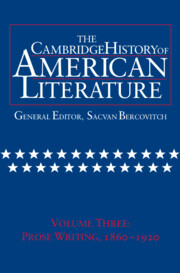Book contents
- Frontmatter
- Introduction
- THE AMERICAN LITERARY FIELD, 1860–1890
- LITERARY FORMS AND MASS CULTURE, 1870–1920
- PROMISES OF AMERICAN LIFE, 1880–1920
- BECOMING MULTICULTURAL: CULTURE, ECONOMY, AND THE NOVEL, 1860–1920
- 1 Introduction
- 2 Remembering civil war
- 3 Social death and the reconstruction of slavery
- 4 Cosmopolitan variations
- 5 Native-American sacrifice in an age of progress
- 6 Marketing culture
- 7 Varieties of work
- 8 Corporate America
- 9 Realist utopias
- Chronology 1860–1920
- Bibliography
- Index
9 - Realist utopias
from BECOMING MULTICULTURAL: CULTURE, ECONOMY, AND THE NOVEL, 1860–1920
Published online by Cambridge University Press: 28 March 2008
- Frontmatter
- Introduction
- THE AMERICAN LITERARY FIELD, 1860–1890
- LITERARY FORMS AND MASS CULTURE, 1870–1920
- PROMISES OF AMERICAN LIFE, 1880–1920
- BECOMING MULTICULTURAL: CULTURE, ECONOMY, AND THE NOVEL, 1860–1920
- 1 Introduction
- 2 Remembering civil war
- 3 Social death and the reconstruction of slavery
- 4 Cosmopolitan variations
- 5 Native-American sacrifice in an age of progress
- 6 Marketing culture
- 7 Varieties of work
- 8 Corporate America
- 9 Realist utopias
- Chronology 1860–1920
- Bibliography
- Index
Summary
It is well known that one of the most popular works of literary utopianism, Edward Bellamy's Looking Backward (1888), was written during the era of American literary Realism; few are familiar with the extraordinary outpouring of utopian novels that appeared between Looking Backward and Charlotte Perkins Gilman's Herland (1915). From the late 1880s to the turn of the century alone, over 150 utopian novels were published in the United States, a figure unequalled in any other country or historical period. It may seem paradoxical, from the perspective of literary history, to find a vogue of utopian art and thought in a culture renowned for its practicality and materialism. But it is precisely the intensity and pace of capitalist development that helps to explain the appeal of utopianism. The utopian novelistic form afforded writers a distance, which facilitated their profound engagement with the economic and social developments that both dazzled and disturbed them. In work after work, narrators and characters experienced the detached contemplation of the utopian perspective. They tested the institutionalization of extreme principles, sometimes radically enlightened ones, as in William Dean Howells's The Traveler From Altruria (1894), sometimes dangerously pessimistic ones, as in Ignatius Donnelly's Caesar's Column (1890). They imagined inventions and scientific advances beyond the ken of contemporaries, as in Alvarado Fuller's A.D. 2000 (1890) and Arthur Bird's Looking Forward (1899). Or, as in Unveiling a Parallel (1893) by Alice Jones and Ella Merchant, they conceived of societies where probable but still remote political changes – women's right to vote and occupational parity with men – had been realized.
- Type
- Chapter
- Information
- The Cambridge History of American Literature , pp. 710 - 740Publisher: Cambridge University PressPrint publication year: 2005

